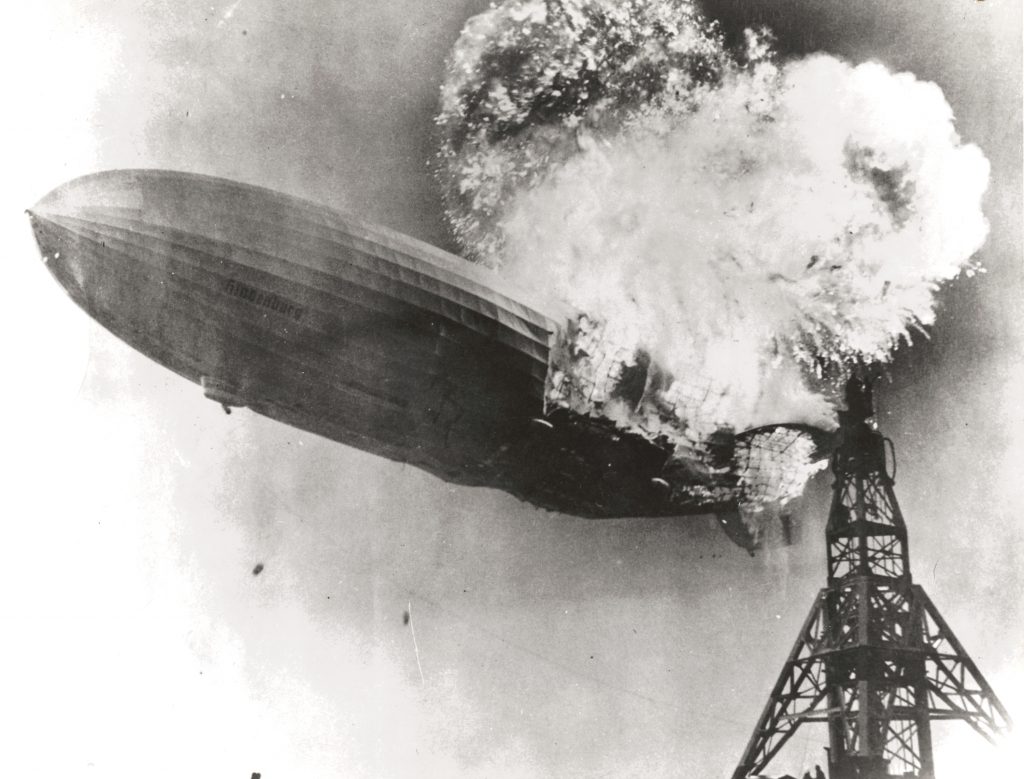With the project extension “P2G++”, the topic of hydrogen safety research made its way into LLEC. We do not only have many years of experience in nuclear safety research, but have also been active in the international HySafe network and the European Hydrogen Safety Panel for many years. Within the scope of the Living Lab, we will deal with scientific work on safety aspects of the hydrogen technologies developed and deployed at LLEC.

Many people immediately think of risks associated with hydrogen.
Source: Gus Pasquerella – http://www.lakehurst.navy.mil/nlweb/images/1213d.gif, Public domain, https://commons.wikimedia.org/w/index.php?curid=632191
Why do so many people immediately think of risks associated with hydrogen? Sure, there have been dramatic accidents in the past. For example, in 1937 the airship “Hindenburg” burst into flames during its descent in Lakehurst. Since the event was broadcast live on the radio (and also three decades later sold millions of copies on a legendary record cover), this event is firmly rooted in American memory. Or in 2011, after the nuclear accident in Fukushima, Japan, videos of hydrogen explosions in the reactor buildings went viral around the world.
Accidents with flammable gases, such as natural gas, are part of everyday life worldwide. Hydrogen has been used safely on an industrial scale for decades, e.g. in the chemical industry. Nevertheless, the idea of using hydrogen in versatile applications in the future arouses particular fears in many people.
It is undisputed that hydrogen has some properties that are of particular relevance to safety. First, it has a low density (14 times lighter than air), which means that leaks can occur more easily than with other gases. In addition, hydrogen has a very wide ignition range (about 7 times wider than for methane), which means that flammable mixtures can form more easily. For mixtures of hydrogen with air, the ignition energy is lower by a factor of 10 than for natural gas/air mixtures. The high flame velocity enables an easier transition to detonations and high combustion pressures.
However, not all properties of hydrogen contribute to an increased risk. For example, the high diffusivity ensures that hydrogen can be easily dispersed and therefore diluted more quickly. Fast combustion combined with the buoyant behavior can lead to less severe fire scenarios, as demonstrated in this video:
Hydrogen is therefore not per se more dangerous than other energy carriers. Rather, it is important to take appropriate safety precautions for the respective area of application. Due to the numerous new and further developments in the field of hydrogen technologies, hydrogen safety is a very active research topic that is continuously expanding the state of the art. The International Association HySafe, for example, organizes international conferences (International Conference on Hydrogen Safety) and Research Priorities Workshops on an annual basis, where a continuous exchange between science and industry takes place. Here, progress is documented and knowledge is published that enables the updating and expansion of technical regulations and safety rules.
A particular challenge is posed by hydrogen technologies that are only just being developed or that are being combined in new ways. Often, international regulations are not yet available for these applications. For our activities in LLEC, this means that we must always keep an eye on international developments in addition to classical safety aspects. In a first step, we will therefore analyze the LLEC technologies with regard to security risks and the status of the corresponding regulations. A look at the “Hydrogen Incident and Accident Database HIAD2.0”, in which more than 700 accidents involving hydrogen all over the world have been compiled, will also help us in this. In addition to findings from accident statistics on particular risks, the experience gathered here helps us to avoid past mistakes. Incidentally, one of the oldest accidents documented in HIAD2.0 is the “Hindenburg” accident mentioned above.
When assessing risks in connection with hydrogen technologies, it is not only the amount of hydrogen available that plays an important role. The experience of the plant operator in handling hydrogen and its safety culture are further essential factors. And last but not least, experience with accidents – as in other areas of occupational safety – shows that safety culture must be lived. The training of employees and the awareness of occupational factors having a direct impact on safety is an important component here.
LLEC offers a fascinating testing ground for new hydrogen technologies. Our research work contributes to ensuring that they can also be operated safely in application after safe trial operation. An important question is the distribution and dispersion of hydrogen. For this purpose, we use CFD simulation (CFD = “Computational Fluid Dynamics”), which makes it possible to reproduce the dispersion of hydrogen in the event of a leakage. How we use these possibilities, for example to evaluate and thus optimize the use of safety measures such as sensors, ventilation or recombiners, will be the subject of one of the next articles in this blog.


No Comments
Be the first to start a conversation